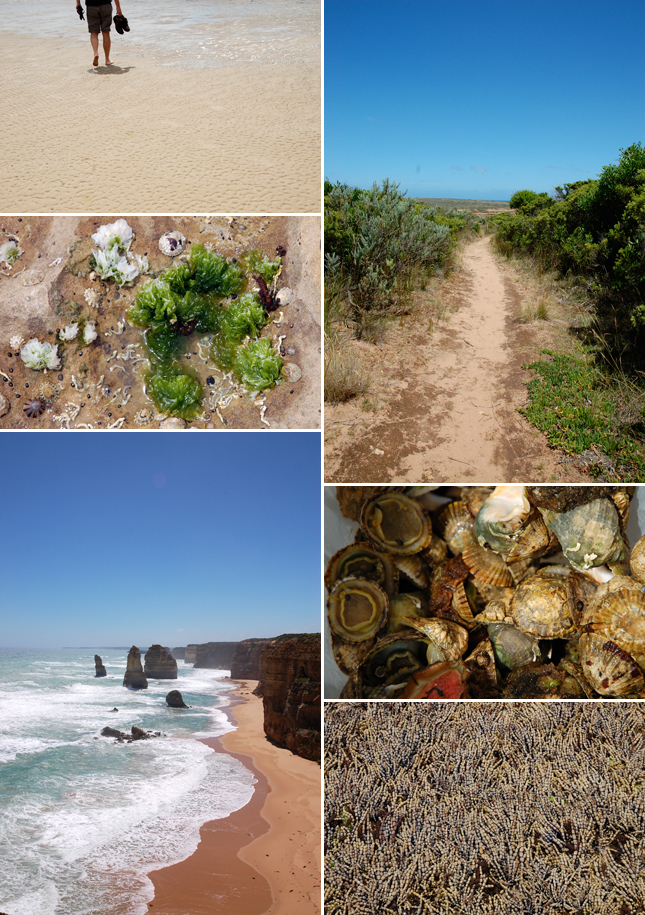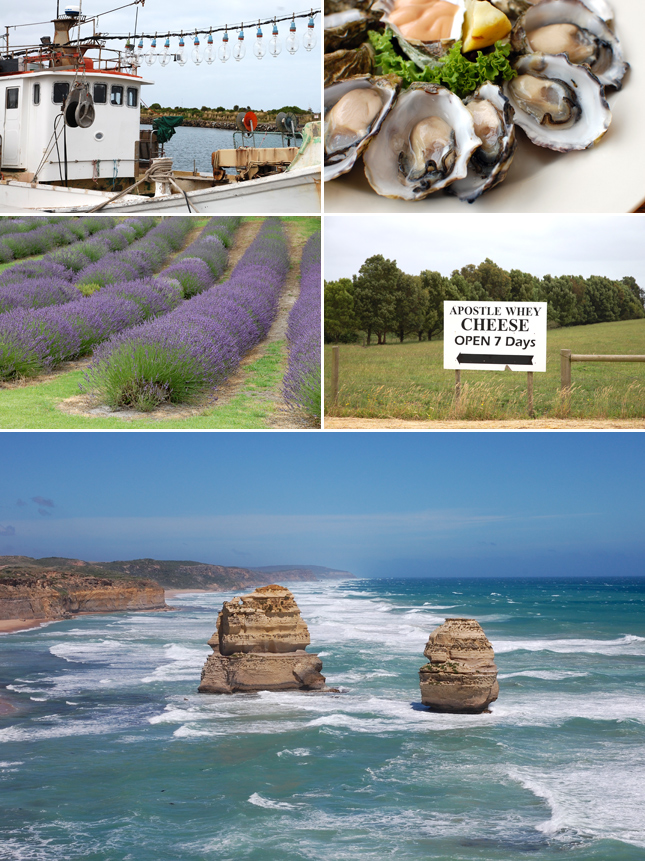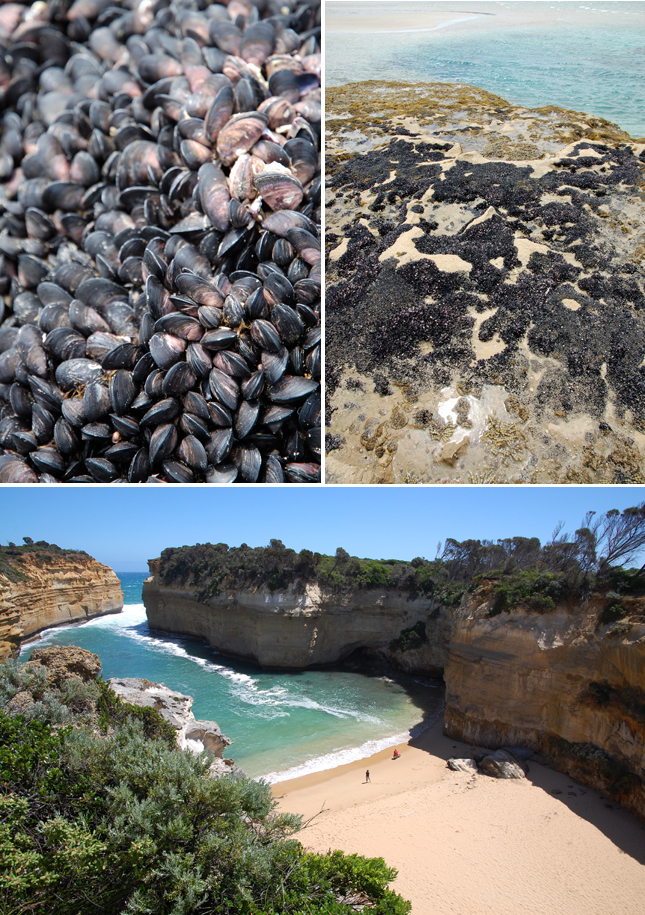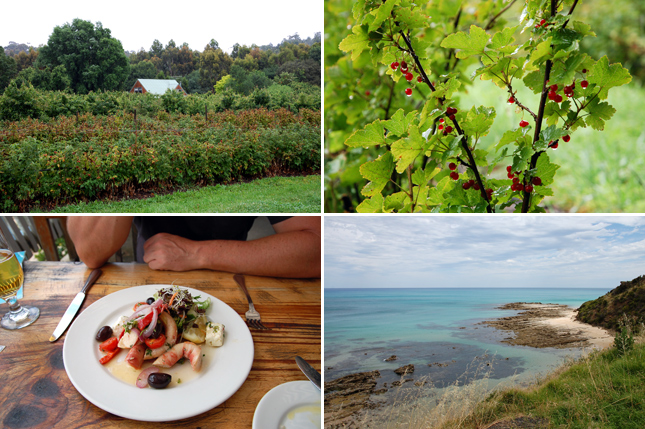Food Along the Great Ocean Road

For centuries the coastline along the length of the southern rim of Australia has been the site of shipwrecks too numerous to count, a place of toppling rock towers where chunks of cliff as big as icebergs erode and drop into the sea. Along these shores of the Great Southern Ocean it isn’t uncommon to experience winds of up to 48 knots / 55 miles / 88 kilometers per hour and observe waves 16 feet / 5 meters tall pounding the shores.
Despite the harshness of the winds and the roughness of the water people have been settling along this stunning coastline for thousands of years, starting with the Aboriginals of the Wathaurong and Gadabanud tribes who harvested the land and ocean with a level of understanding and efficiency that still astounds. In the 1800s white settlers arrived and less than kindly drove the indigenous people out. In their place they built fishing villages, set up cattle and sheep stations (ranches) and began to work the soil. Inhabitants of these truly isolated townships literally lived on the fringes of civilization and had few options when it came to travel or taking their goods to markets farther than the next village.

In the 1870s a group of farsighted businessmen sought to remedy the situation and proposed that a road be built. Surveying for the 250 mile / 400 kilometer road was expected to take three months and began in earnest in 1918 with a labor force comprised almost entirely of soldiers just back from the trenches of World War I. By March of 1919 only ten miles had been marked out.
Workers, or “diggers” as they came to be known, of the lanes that are now the Great Ocean Road used mostly pick axes, shovels, some dynamite and their bare hands to build the road. Overall, working conditions were not too awful. Pay was decent and accommodation was provided. Supplies were fairly steady and natural sources of food were plentiful and the workmen were encouraged to hunt and fish for their dinners. There were also lots of opportunities for the “diggers” to enjoy their leisure time. An especially long break was taken in 1924 when a steamer called the Casino ran aground on a reef. Hoping to lighten the ship enough to float free the ship’s captain ordered that the cargo be tossed. In this instance the cargo included 500 barrels of beer and 120 cases of hard liquor. The diggers found the castoff cargo and had a party that lasted two weeks.
With the road officially finished in 1932 moving goods was possible and farming became a viable profession for many in the area.
Inland and along the water the region serviced by the Great Ocean Road has become one of Australia’s better culinary destinations. Each of the oceanside villages has its own array of restaurants, delis and bakeries offering great local food. Numerous fisherman co-ops dot the coast. Heading away from the water there are dairies making some of Australia’s best cheeses. There are orchards and berry patches a few miles from the town of Lorne where you can pick your own fruit then have a cup of tea and chat with your fellow fruitiers.

If one is heading west the acknowledged start of the road is the town of Geelong, though visually it feels more like the town of Torquay, one of Australia’s best surf spots, is the starting point. From here to the Otway National Park the road stays along the coast where desolate beaches await and where one can venture far from shore at low-tide to harvest limpets, or lampas as they are known in Spanish. These hump-shaped gastropods are often used as fishing bait but along the shores of the Mediterranean they are used in stews or simply grilled. Of course there are other shellfish to be had such as mussels and oysters, many that are growing wild along the shore or are aquafarmed in numerous harbors. Cuttlefish, crayfish— the local kind of lobster— and gummy shark also known as flake, are also plentiful. For freshwater options there are yabbis (is it a really big prawn or a fairly small lobster?) and maron that are caught in the various estuaries.
Just beyond the half way point of the drive is the quiet village Port Campbell— the stay-over point for the most famous, and rightly so, section of the Great Ocean Road, the 12 Apostles. The number of these 147 foot / 45 meter tall towers of limestone, has now dropped to eight with the most recent tower collapse in 2005. Formerly known as the Sow and Piglets the towers were later given a more pious sounding name based on the local belief that more people would come to see a sight with a religious sounding name as opposed to a more earthy moniker. Whatever the name the stone piles are spectacular and worth visiting at different hours of different days to see how the light shifts on the formations. Between visits one can drive inland to the Wine and Vistas Loop, a 71 mile / 115 kilometer drive that goes toward the town of Timboon and passes the famous Apostle Whey Cheese Factory. Regardless of whether you take the Loop route, a visit to the cheese shop is worth the time for their camembert and brie. Tastings are free but it’s polite to buy if you try.
Also near Port Campbell are other costal stops equally as stunning as the 12 Apostles, among them Loch Ard, Bay of Islands, Gibson Steps, The Grotto and London Arch.
The Great Ocean Road officially ends at the town of Warrnambool. The section that continues becomes the Costal Explorer’s Way. This less storied section of road moves through Port Fairy, an active fishing village where one can charter boats for private fishing excursions or grab a pint at one of the many old-time pubs, and then on to the less picturesque Portland Bay. From here the roads head inland and north toward Lake Alexendria and the mouth of the Murray River. At this junction an entirely new culinary drive begins.







 Share Article
Share Article